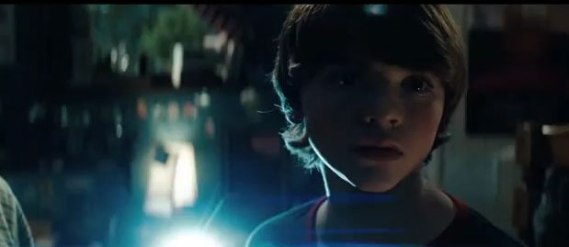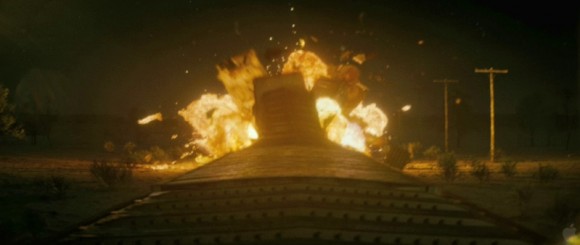All About Steve: Super 8
By Adam Nayman
Put on the spot in an interview about why there were so many lens flares in his reboot of Star Trek (2009), J.J. Abrams joked that it was “because the future was so bright that it couldn’t be contained in the frame.” Super 8, which takes place in a 1979 that is in its own way as meticulously production-designed as the bridge of the U.S.S. Enterprise, features fewer of these blinding blips, but they’re still integrated into the overall visual design in a way that begs our indulgence—and inquiry.
Appropriately for something that makes it difficult to look directly at the screen, the meaning of this literally flashy technique can be a little bit tricky to discern. The artificial lens flare is a manufactured defect, a means of approximating the fallibility of human vision even when all or part of what’s being glimpsed by the camera eye has been created in a digital void—making it the perfect aesthetic signature for the CGI era. But Abrams, supposedly, is some kind of throwback analog figure: a commercial entertainer more interested in building his characters than blowing them up. How anyone could seriously make this assertion after seeing this transplanted television-auteur’s choices of feature film material (two mammoth studio franchises) is another good question, but we’ll go with it long enough to point out that the best thing about Super 8 is a scene that directly interrogates its director’s relationship to cinematic spectacle—a scene framed by, you guessed it, a lens flare.
At least in this case the light source is diegetic: it’s the reflection of the makeshift lighting set-up being employed by a group of middle-school filmmakers, plying their trade on a deserted train platform a few miles outside their backwater Ohio hometown. The director, Charles (Riley Griffiths), is a pudgy, pushy martinet with high aspirations for his backyard zombie flick; hoping for gooey verisimilitude, he’s employed his manually adept and socially inept pal Joe (Joel Courtney) as a makeup artist. The other members of the all-male crew occupy various points along the same freaky-geeky axis: junior firebug/FX wrangler Cary (Ryan Lee) just wants to put a lit match to objects on the set, while leading man Martin (Gabriel Basso) is gawky and over-emotional in inverse proportion to the crusading investigator he’s supposed to be playing.
The wild card is Alice (Elle Fanning), the slightly older girl that Charles has conned into appearing in his opus. (Godard was right, though that’s probably one unintentional allusion in a film full of direct ones). Alice isn’t dumb—she knows she’s being used on a number of levels, not the least of which is as chauffeur—and she’s not a prop, either. Her unexpectedly harrowing delivery of the stilted and ridiculous monologue Charles has written for her character is the pre-teen equivalent of Naomi Watts’ indelible audition scene in Mulholland Dr. (2001), and a subtle evocation of film’s capacity for imaginative illusion. Decked out in an adolescent boy’s idea of housewife-chic and plastered with makeup (applied by a smitten Joe, who will later also transform her into a fetching tween zombie), she’s her own sad, willowy special effect.
Charles, Joe and the others are transfixed, but only for a moment: the whistle of an approaching train breaks the spell and confirms the little-boy mentality underpinning their painstakingly grown-up endeavours. “Production value!” shouts Charles, his gimlet eyes shining wide, and suddenly the entire shoot is being reshuffled to accommodate the train’s swiftly approaching (and increasingly deafening) presence. It’s a good self-reflexive gag that also happens to be the first real plot point: Charles and Abrams both get their production value’s worth when a pickup truck barrels onto the tracks (spotted only by Joe) and causes a derailment, leading to what may not be the best train crash in film history, but almost certainly the loudest. In the aftermath, the truck’s badly wounded driver offers a cryptic warning that seems to imply that something weird has survived the wreck—and that some very scary people are en route to retrieve it.
It is at this point that Super 8 shifts from a tribute to the mythical Spielbergian ethos of movie-brat-rite-of-passage to a run-through of Spielbergian references, starting with the fact that the truck driver is Glenn Turman, a.k.a. Mr. Hanson from Gremlins (the science teacher who takes a knife to the chest). The military-issue flashlights cutting through the field en route to his smashed vehicle are meanwhile straight out of E.T. (1982), as is the cramped, profane atmosphere of Charles’ sibling-infested home. And the hits just keep on coming: as Joe and his friends come to realize the true nature of the escaped cargo and the ruthless dispatch of the military (personified by the craggy, Clancy Brown-ish countenance of Noah Emmerich) to retrieve it, we get entire set-pieces lifted from Raiders of the Lost Ark (1981) and The Lost World: Jurassic Park (1997), all leading up to a climax that splits the difference between War of the Worlds (2004) and Close Encounters of the Third Kind (1977), with a little bit of (the Spielberg-produced) The Goonies (1986) thrown in for good measure.
One might blanch at the idea of an homage executive-produced by its own subject; after all, it’s not like Quentin Tarantino got Richard C. Sarafian to sign off on Death Proof (2007). That’s a dumb comparison, maybe, but I’m not so sure that Super 8 isn’t just a chaster, more broadly aimed version of Grindhouse (2007), luxuriating in the textures of pre-multiplex blockbusters as a way of teaching the kids about the good old days while also tickling their parents’ (or VHS-educated older siblings’) escapist pleasure centres. My problem with the Tarantino-Rodriguez wing of appreciationist filmmaking is the way it (unintentionally) condescends to its sources of worship: a lot of money gets spent trying to prove the pleasures of cheap pulp fiction. Abrams’ problem is different, if not entirely unrelated: since his professional hero helped to initiate the cycle of big-budget creature movies, his choice is to either try to strip things down or do the same thing even bigger, drawing on the sorts of technical resources made industry-issue by the unprecedented success of Jaws (1975) and everything that came after.
Except that Jaws is a palpably hand-crafted movie where, as has been written at length, necessity became the mother of invention. Abrams attempts the same kind of slow-burn in Super 8, but it’s more disingenuous; as in the at once more accomplished and less likeable Cloverfield (2007), which he produced, the gradual reveal of the monster is a tease that doesn’t pay off. I’m not one to niggle over creature design (and I liked the Geiger-meets-Lovecraft design of Cloverfield‘s bogey), but the team responsible for imagining and animating Super 8‘s extra-terrestrial antagonist failed in their half of the battle. It would be something else entirely if the cheesiness of the monster was part of the point, and indeed there’s a brief, expository newsreel-style aside where that’s precisely what’s going on, with a military scientist plucked cartoon-style off the ground by a swinging tentacle (shades of Verhoeven’s Starship Troopers [1997], which cheerfully demolished a generation of Hollywood filmmaking instead of offering up wet, sloppy kisses).
For the most part, though, Super 8 aspires to be kinetic, did-you-see-that entertainment, and Abrams never quite finds the pounding rhythm required for that kind of affect. Nor does he mine his early-Spielberg templates for the one quality that might have really helped out: their ruthlessness. By the time of E.T.’s deathbed resurrection, Spielberg showed that he no longer had the stomach to really punish an audience (in its place was a bleeding, glowing red heart), but Jaws had the stones to kill a kid in a geyser of blood twenty minutes in, and before its climactic, feel-good light show Close Encounters is a truly frightening alien-invasion thriller. Encounters’ cosmic Christmas-tree grandeur was a means of releasing accumulated tension; when Super 8 finally drags its bulk in the same direction, it’s a programatically reverent urge, the filmic equivalent of muscle memory.
The strenuous agape of the closing scenes doesn’t square with the (mostly neutered) monster-movie carnage that comes before, and while there’s some intricacy to the script’s emotional architecture there’s also something bludgeoning about it: Joe and Alice’s respective and then intertwined daddy issues get worked out with the rigour and finality of a zero-sum mathematical equation. Abrams gives us what he expects we want in a cathartic final lift-off, but the scale is wrong. Before we’ve really had a chance to process what we’ve seen, something that should be huge and overwhelming has been reduced to a narrowing blue point of light: it’s that Abramsian lens flare again, and it’s a fitting enough capper to a movie that provides only a fleeting illumination of its maker’s movie love.
Do stay for the end credits, though: that stuff is pretty funny.
Adam Nayman- « Previous
- 1
- 2




